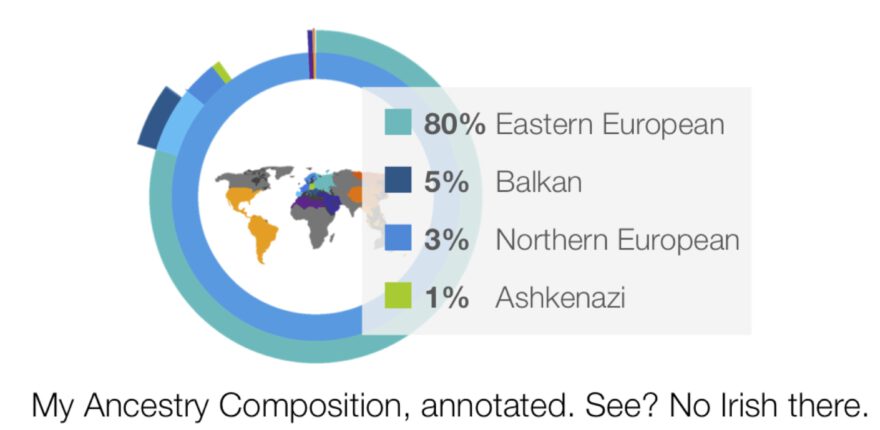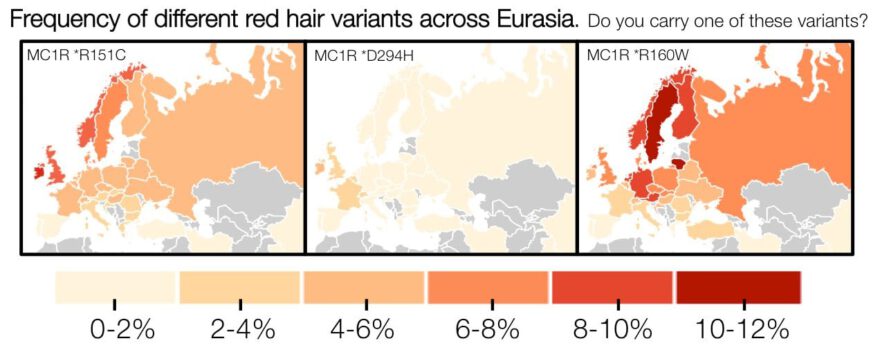So where did that red hair come from?
by Kasia Bryc, 23andMe Population Geneticist
Most people who see my unruly wild 
I’m not.
As a first generation immigrant from Poland, I don’t have any ancestors from Ireland.
Recessive Trait
Yes, really, just take a look at my 23andMe Ancestry Composition results.
Yet it is true that red hair is strongly tied to Ireland. Over 10 percent of 23andMe customers of Irish heritage, whose four grandparents were born in Ireland, have red hair. In most other parts of continental Europe, red hair is less common, and its frequency tends to hover between one and three percent.
For me, my red hair holds special significance. Both my parents had brown hair, yet both my brother and I have red hair, thanks to the joys of recessive inheritance (No, we’re not adopted. And yes, our family relationships have been confirmed genetically through 23andMe).
Red hair acts, for the most part, like a recessive trait, meaning that you need two copies of the red-hair genetic variant to see red hair. Which explains why my parents, each carrying one copy of the variant, didn’t have red hair, but could pass it on to their children by chance, which they did, twice.

As a child I puzzled over my hair color – it seemed rather poor camouflage, and surely ill-adapted – how could a trait as odd as red hair have come to be?
That early fascination with human traits and evolution helped lead me to a career as a population geneticist. Nowadays I love wrangling with just such questions as I study the genetics of people across the globe.
The red hair gene
To dive into the genetics of red hair, we first have to understand the function of a gene called the Melanocortin 1 Receptor (MC1R). MC1R acts as a lever that toggles the cells to produce a brown or black pigment instead of producing a reddish yellow pigment. The color of the pigment, and how much is produced, leads to much of the diversity in appearance of humans around the world.
Genetic mutations can change the normal function of MC1R, leading to a loss of function. That means that the protein the gene makes is changed so much that it doesn’t work as it should. So the pigment-producing cells don’t get their signal to make black-brown pigment that is so protective against the sun’s harmful UV rays,and instead produce more reddish yellow pigment, which, in your hair, gives it a red color.
About 90 percent of 23andMe customers who report having red hair carry at least one of three of the most common genetic variants associated with red hair variants. Though there are other known and unknown variants involved in determining human pigmentation.
Do you carry one of these variants associated with red hair?
Three variants highly associated with red hair among 23andMe customers. Not yet a customer? Visit our store!
The evolution of red hair
For a long time, red hair was thought to be an adaptive trait. Not the hair color itself, but rather, red hair and lighter skin pigmentation are a bit of a package deal, and this lighter pigmentation was thought to be adaptive in northern Europe. Lighter skin color allows the skin to produce sufficient vitamin D when levels of light are low, when you don’t get sufficient levels of the vitamin through your food (such as from fish). So if you were a farmer in, say, Ireland, lighter skin would help you keep your vitamin D levels sufficiently high.
However, there has been a surprising dearth of evidence for positive selection of red hair in Europeans, and there seems to be no association between red hair and the evolution of light skin in European populations. In contrast, the gene SLC24A5, which is involved with skin pigmentation, has a strong signal of selection. So it seems that for red hair, the vitamin D hypothesis isn’t really substantiated by science.
Lack of selection
Instead, the current theory most evolutionary scientists believe suggests that selective pressure to maintain proper protective black-brown pigmentation is highly constrained in regions closer to the equator that have strong sun exposure. The production of black-brown pigment, necessitating a functioning MC1R gene, helps shield cells from ultraviolet radiation that can increase the risk of skin cancer.
In the far north, it seems, that selection may be relaxed. Comparing the human MC1R gene sequence to a chimpanzee’s genome suggests there was a lot of functional constraint on this gene… right up until humans migrated out of Africa. Mutations in MC1R that take away production of black-brown pigment may matter less where the sunlight isn’t as powerful. As a result, we observe these mutations, and the accompanying red hair. Sometimes, the mutations drift up in frequency by chance, and red hair becomes (more) common.
For an even more nuanced contemplation of skin pigmentation and adaptation, and its possible relationship to the switch from hunter-gatherer lifestyles to farming, check out this read.

Where are 23andMe customers with red hair from?
A closer look at the three most common red hair variants among 23andMe customers shows that red hair allele frequency in Europe does correlate with distance from the equator. The variant that is most common (and is involved in a third of red hair among 23andMe customers) is R151C. Unsurprisingly, this variant is most common in individuals whose grandparents were born in Ireland and in the UK.
Over 50 percent of 23andMe redheads carry at least one copy of this variant. Are you one of them?
The variant D294H is also most frequent in Ireland, but overall it is less prevalent, and found in a limited range: mostly Ireland, the UK, and France, Switzerland, and Belgium.
Unlike the first two, the variant that I carry, R160W, isn’t most common in Ireland. Instead, it is found at its highest frequencies in Sweden and Lithuania, as well as other parts of Scandinavia, Central and Eastern Europe.
So what do these maps of variants tell us about why red hair might have come to be?
Well, there does seem to be a correlation between where the variants lie – each variant is most frequent above the 35th parallel, which suggests that there may really be a relaxed selective constraint on MC1R function this far north of the equator.
 Research
Research
In researching traits among 23andMe customers, I learned a lot about red hair. I was amazed at how the genetics of just one trait are so complex. For example, not everyone with two MC1R variants reports having red hair. Isn’t that how recessive traits should work?
But instead, red hair variants aren’t completely penetrant, meaning they don’t always cause the trait. The variant that I carry, R160W, is especially illustrative: only 50 percent of individuals that carry two copies of this variant have red hair.
On a personal level, I felt reassured that what I knew about my family’s history was consistent with what I found to be true about red hair. But even more, I realized just how widespread red hair variants are across Europe, especially its northern reaches.




